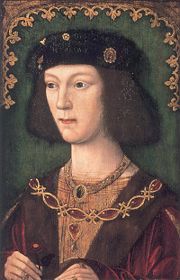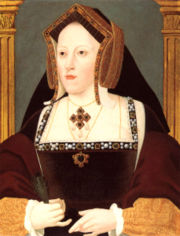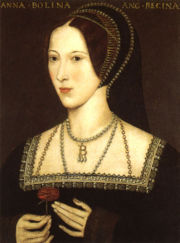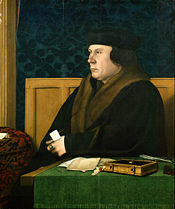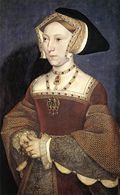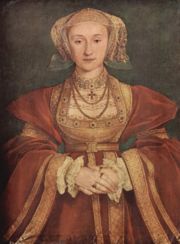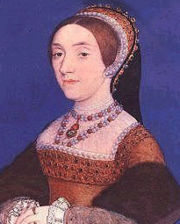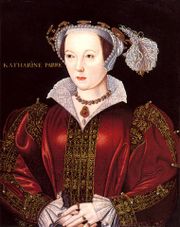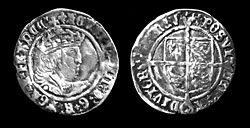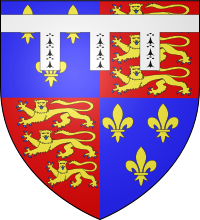Henry VIII of England
2008/9 Schools Wikipedia Selection. Related subjects: Monarchs of Great Britain
| Henry VIII | |
|---|---|
| King of England; King of Ireland; prev. Lord of Ireland (more...) | |
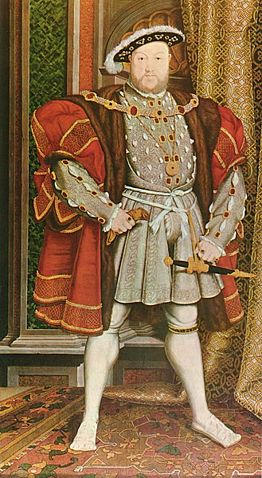 |
|
| Reign | 21 April 1509 – 28 January 1547 |
| Coronation | 24 June 1509 |
| Predecessor | Henry VII |
| Successor | Edward VI |
| Consort | Catherine of Aragon m. 1509, ann. 1533 Anne Boleyn |
| Issue | |
| Mary I Henry FitzRoy Elizabeth I Edward VI |
|
|
Detail Titles and styles |
|
| His Majesty The King His Grace The King The Prince of Wales The Duke of York Prince Henry |
|
| Royal house | House of Tudor |
| Father | Henry VII |
| Mother | Elizabeth of York |
| Born | 28 June 1491 Greenwich Palace, Greenwich |
| Died | 28 January 1547 (aged 55) Palace of Whitehall, London |
| Burial | St George's Chapel, Windsor Castle |
Henry VIII ( 28 June 1491 – 28 January 1547) was King of England and Lord of Ireland, later King of Ireland and claimant to the Kingdom of France, from 21 April 1509 until his death. Henry was the second monarch of the House of Tudor, succeeding his father, Henry VII.
Henry VIII was a significant figure in the history of the English monarchy. Although in the first parts of his reign he energetically suppressed the Reformation of the Anglican Church, which had been building steam since John Wycliffe of the fourteenth century, he is more often known for his ecclesiastical struggles with Rome. These struggles ultimately led to him separating the Anglican Church from Roman authority, the Dissolution of the Monasteries, and establishing the English monarch as the Supreme Head of the Church of England. Although some claim he became a Protestant on his death-bed, he advocated Catholic ceremony and doctrine throughout his life; royal backing of the English Reformation was left to his heirs, Edward VI and Elizabeth I. Henry also oversaw the legal union of England and Wales (see Laws in Wales Acts 1535–1542). He is noted in popular culture for being married six times.
Early years (1491-1509)
Born in Greenwich Palace, Henry VIII was the third child of Henry VII and Elizabeth of York. Of the young Henry's six siblings, only three — Arthur (the Prince of Wales), Margaret, and Mary — survived infancy. In 1493, Henry was appointed Constable of Dover Castle and Lord Warden of the Cinque Ports. In 1494, he was created Duke of York. He was subsequently appointed Earl Marshal of England and Lord Lieutenant of Ireland. Henry was given a first-rate education from leading tutors, becoming fluent in Latin, French, and Spanish. As it was expected that the throne would pass to Prince Arthur, Henry's older brother, Henry was prepared for a career in the Church.
Death of Arthur
In 1502, Arthur died suddenly of an unknown disease, tuberculosis, perhaps. Arthur's death thrust all his duties upon his brother Henry, who then became Prince of Wales. Henry VII renewed his efforts to seal a marital alliance between England and Spain, by offering Henry, Prince of Wales, in marriage to Prince Arthur's widow, Catherine of Aragon, the youngest surviving child of King Ferdinand II of Aragon and Queen Isabella I of Castile.
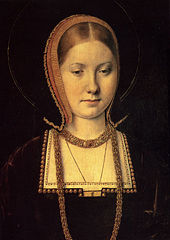
In order for the new Prince of Wales to marry his brother's widow, a dispensation from the Pope was normally required to overrule the impediment of affinity. Catherine swore that her marriage to Prince Arthur had been unconsummated. Still, both the English and Spanish parties agreed that an additional papal dispensation of affinity would be prudent to remove all doubt regarding the legitimacy of the marriage.
The impatience of Catherine's mother, Queen Isabella, induced Pope Julius II to grant dispensation in the form of a Papal bull, and fourteen months after her young husband's death, Catherine found herself betrothed to his even younger brother, Henry, the new Prince of Wales. Yet by 1505, King Henry VII lost interest in a Spanish alliance, and the younger Henry declared that his betrothal had been arranged without his consent.
Continued diplomatic maneuvering over the fate of the proposed marriage lingered until the death of Henry VII in 1509. Only 17 years old, Henry married his brother's widow, Catherine, on 11 June 1509, and on 24 June 1509, the two were crowned at Westminster Abbey. Two days later, he arrested his father's two most unpopular ministers, Sir Richard Empson and Edmund Dudley. They were groundlessly charged with high treason and in 1510, the king had them executed. This was to become Henry's primary tactic for dealing with those who stood in his way.
France and the Habsburgs (1509-1525)
Henry was a Renaissance Man and his court was a centre of scholarly and artistic innovation and glamourous excess, epitomised by The Field of the Cloth of Gold. He was an accomplished musician, author, and poet. His best known musical composition is Pastime with Good Company or The Kynges Ballade. He was also known to have been an avid gambler and dice player. He excelled at sports, especially jousting, hunting, and tennis. The king was also known for his strong dedication to the Christian faith.
| The Six Wives of King Henry VIII |
|---|
In 1511, Pope Julius II proclaimed a Holy League against France. This new alliance rapidly grew to include not only Spain and the Holy Roman Empire, but also England. Henry decided to use the occasion as an excuse to expand his holdings in northern France. He concluded the Treaty of Westminster, a pledge of mutual aid against the French with Spain, in November 1511 and prepared for involvement in the War of the League of Cambrai. In 1513, Henry invaded France and his troops defeated a French army at the Battle of the Spurs. James IV of Scotland invaded England at the behest of Louis, but he failed to draw Henry's attention from France. The Scots' disastrous defeat at the Battle of Flodden Field took place on 9 September 1513. Among the dead were the Scottish King and the battle ended Scotland's brief involvement in the war.
On 18 February 1516, Queen Catherine bore Henry one of his four children to reach adulthood, Princess Mary, who later reigned as Mary I.
Mistresses
Historians are sure of the names of only two of Henry's mistresses: Elizabeth Blount (usually referred to as Bessie) and Mary Boleyn (Anne's sister). Elizabeth Blount gave birth to Henry's illegitimate son, Henry FitzRoy. The young boy was made Duke of Richmond in June 1525 in what some thought was one step on the path to legitimatizing him. In 1533, he married Mary Howard, Anne Boleyn's first cousin, but died only three years later without any successors. At the time of FitzRoy's death, the king was trying to get a law passed that would allow his otherwise illegitimate son to become king.
Mary Boleyn was the sister of Anne Boleyn. She is thought to have been his mistress at some point between 1519 and 1526. Historians have speculated that Mary Boleyn's two children, Catherine and Henry were fathered by Henry, but this has never been proven and the King never acknowledged them as he did Henry Fitzroy.
The king also had a brief, six-month affair with Mary Shelton sometime in 1535. Mary has also been confused with her sister, Margaret. However, it has been confirmed that it was in fact Mary and not Margaret Shelton with whom Henry had the affair.
Henry's "great matter" (1525-1533)
In 1525, Henry's impatience with what he perceived to be Catherine's inability to produce the desired heir increased when he became attracted to a charismatic young woman in the Queen's entourage, Anne Boleyn. Henry became enamoured with her and began his pursuit. Boleyn resisted his attempts to seduce her and she refused to become his mistress, as her sister Mary Boleyn had. Henry was all the more attracted to her because of this refusal and he pursued her relentlessly. Boleyn continued to reject the King’s initial advances by saying, “I beseech your highness most earnestly to desist, and to this my answer in good part. I would rather lose my life than my honesty.”
It is possible that the idea of annulment had suggested itself to the King much earlier than this, and it is highly probable that it was motivated by his desire for a male heir. Before Henry's father Henry VII ascended the throne, England had been beset by civil warfare over rival claims to the English crown and Henry wanted to avoid a similar uncertainty over the succession. The King had no sons due to the death in infancy of all Catherine of Aragon's children except his daughter Mary. Anne saw her opportunity in Henry's infatuation and determined that she would only yield as his acknowledged queen.
It soon became the one absorbing object of the King's desires to secure an annulment from Catherine. Henry set his hopes upon a direct appeal to the Holy See, acting in this independently of Thomas Cardinal Wolsey, to whom he at first communicated nothing of his plans so far as they related to Anne. William Knight, the king's secretary, was sent to Pope Clement VII to sue for the annulment of his marriage with Catherine. The grounds were that the dispensing bull of Pope Julius II was obtained by false pretenses, because Catherine's brief marriage to the sickly Arthur had in fact been consummated. Henry also petitioned, in the event of his becoming free, a dispensation to contract a new marriage with any woman even in the first degree of affinity, whether the affinity was contracted by lawful or unlawful connection. This clearly had reference to Anne.
As the pope was at that time the prisoner of Emperor Charles V, Knight had some difficulty in obtaining access to him. In the end the king's envoy had to return without accomplishing much, though the conditional dispensation for a new marriage was granted. Henry had now no choice but to put his great matter into the hands of Thomas Wolsey, and Wolsey did all he could to secure a decision in the King's favour. How far the pope was influenced by Charles V in his resistance is difficult to say, but it is clear Henry saw that the Pope was unlikely to give him an annulment from the Emperor's aunt. The pope forbade Henry to proceed to a new marriage before a decision was given in Rome. Convinced that he was treacherous, Anne Boleyn maintained pressure until Wolsey was dismissed from public office in 1529. After being dismissed, the cardinal begged her to help him return to power, but she refused. He then began a secret plot to have Anne forced into exile and began communication with Queen Catherine and the Pope to that end. When this was discovered, Henry ordered Wolsey's arrest and had it not been for his death from a terminal illness in 1530, he might have been executed for treason. His replacement, Sir Thomas More, initially cooperated with the king's new policy, denouncing Wolsey in Parliament and proclaiming the opinion of the theologians at Oxford and Cambridge that the marriage of Henry to Catherine had been unlawful. As Henry began to deny the authority of the Pope, More's qualms grew.
A year later, Queen Catherine was banished from court and her old rooms were given to Anne. With Wolsey gone, Anne now had considerable power over government appointments and political matters. When Archbishop of Canterbury William Warham died, Anne had the Boleyn family's chaplain, Thomas Cranmer, appointed to the vacant position. Through the intervention of the King of France, this was conceded by Rome, the pallium being granted to him by Clement.
The breaking of the power of Rome in England proceeded little by little. In 1532, a lawyer who was a supporter of Anne, Thomas Cromwell, brought before Parliament a number of acts including the Supplication against the Ordinaries and the Submission of the Clergy, which recognised Royal Supremacy over the church. Following these acts, Thomas More resigned as Chancellor, leaving Cromwell as Henry's chief minister.
Second marriage
Henry attended a meeting with the French king at Calais in the winter of 1532, in which he hoped he could enlist the support of Francis I of France for his new marriage. The conference at Calais was a political triumph, since the French government gave its support for Henry's re-marriage. Immediately upon returning to Dover in England, Henry and Anne went through a secret wedding service. She soon became pregnant and, as was the custom with royalty, there was a second wedding service, which took place in London on 25 January 1533. Events now began to move at a quick pace. On 23 May 1533, Cranmer, sitting in judgment at a special court convened at Dunstable Priory to rule on the validity of the king's marriage to Catherine of Aragon, declared the marriage of Henry and Catherine null and void. Five days later, on 28 May 1533, Cranmer declared the marriage of Henry and Anne to be good and valid.
Catherine was formally stripped of her title as queen and Anne was consequently crowned queen consort on 1 June 1533. The queen gave birth slightly prematurely on 7 September 1533. Anne had given birth to a girl who was christened Elizabeth, in honour of Henry's mother, Elizabeth of York. Rejecting the decisions of the Pope, Parliament validated the marriage between Henry and Anne with the Act of Succession 1533. Catherine's daughter, the Lady Mary, was declared illegitimate, and Anne's issue were declared next in the line of succession. Included in this declaration was, most notably, a clause repudiating "any foreign authority, prince or potentate". All adults in the Kingdom were required to acknowledge the Act's provisions by oath and those who refused to do so were subject to imprisonment for life. The publisher or printer of any literature alleging that Henry's marriage to Anne was invalid was automatically guilty of high treason and could be punished by death.
English Reformation (1533-1540)
Meanwhile, the House of Commons had forbidden all appeals to Rome and exacted the penalties of præmunire against all who introduced papal bulls into England. The Commons also prevented the Church from making any regulations without the King's consent. It was only then that Pope Clement at last took the step of launching sentences of excommunication against the King and Cranmer, declaring at the same time the archbishop's decree of annulment to be invalid and the marriage with Anne null and void. The papal nuncio was withdrawn from England and diplomatic relations with Rome were broken off. Several more laws were passed in England. The Ecclesiastical Appointments Act 1534 required the clergy to elect bishops nominated by the Sovereign. The Act of Supremacy 1534 declared that the King was "the only Supreme Head in Earth of the Church of England" and the Treasons Act 1534 made it high treason, punishable by death, to refuse to acknowledge the King as such. In response to the excommunications, the Peter's Pence Act was passed in and it reiterated that England had "no superior under God, but only your Grace" and that Henry's "imperial crown" had been diminished by "the unreasonable and uncharitable usurpations and exactions" of the Pope. In defiance of the Pope, the Church of England was now under Henry’s control, not Rome's.
Personal troubles
The king and queen were not pleased with married life. The royal couple enjoyed periods of calm and affection, but Henry's frequent infidelities greatly upset his new wife, who reacted with tears and rage to each new mistress. For his part, Henry disliked Anne’s constant irritability and violent temper. After a false pregnancy or miscarriage in 1534, he saw her failure to give him a son as a betrayal. As early as Christmas 1534, Henry was discussing with Cranmer and Cromwell the chances of leaving Anne without having to return to Catherine.
Opposition to Henry's religious policies was quickly suppressed in England. A number of dissenting monks were tortured and executed. The most prominent resisters included John Fisher, Bishop of Rochester, and Sir Thomas More, Henry's former Lord Chancellor, both of whom refused to take the oath to the King and were subsequently convicted of high treason and beheaded at Tyburn. These suppressions in turn contributed to further resistance among the English people, most notably in the Pilgrimage of Grace, a large uprising in northern England in October of the same year. Henry VIII promised the rebels he would pardon them and thanked them for raising the issues to his attention, then invited the rebel leader, Robert Aske to a royal banquet. At the banquet, Henry asked Aske to write down what had happened so he could have a better idea of the problems he would 'change'. Aske did what the King asked, although what he had written would later be used against him as a confession. The King's word could not be questioned (as he was held as God's chosen, and second only to God himself) so Aske told the rebels they had been successful and they could disperse and go home. However, because Henry saw the rebels as traitors, he did not feel obliged to keep his promises. The rebels realised that the King was not keeping his promises and rebelled again later that year, but their strength was less in the second attempt and the King ordered the rebellion crushed. The leaders, including Aske, were arrested and executed for treason. Dissolution of the remaining, larger monasteries followed a subsequent authorising act by Parliament in May 1539.
Execution of Anne Boleyn
On 8 January 1536 news reached the king and the queen that Catherine of Aragon had died. Upon hearing the news of her death, Henry and Anne reportedly decked themselves in bright yellow clothing. Henry called for public displays of joy regarding Catherine's death. The queen was pregnant again, and she was aware of the consequences if she failed to give birth to a son. Her life could be in danger, as with both wives dead, Henry would be free to remarry and no one could claim that the union was illegal. Later that month, the King was unhorsed in a tournament and was badly injured. It seemed for a time that the King's life was in danger. When news of this accident reached the queen she was sent into shock and miscarried a male child that was about 15 weeks old. This happened on the very day of Catherine’s funeral, 29 January 1536. For most observers, this personal loss was the beginning of the end of the royal marriage.
Given the King's desperate desire for a son, the sequence of Anne's pregnancies has attracted much interest. Author Mike Ashley speculated that Anne had two stillborn children after Elizabeth's birth and before the birth of the male child she miscarried in 1536. Most sources attest only to the birth of Elizabeth in September 1533, a possible miscarriage in the summer of 1534, and the miscarriage of a male child, of almost four months gestation, in January 1536. As Anne recovered from what would be her final miscarriage, Henry declared that his marriage had been the product of witchcraft. The King's new mistress, Jane Seymour, was quickly moved into new quarters. This was followed by Anne's brother being refused a prestigious court honour, the Order of the Garter, which was instead given to Jane Seymour's brother.
Five men, including Anne's own brother, were arrested on charges of incest and treason, accused of having sexual relationships with the queen. On 2 May 1536 Anne was arrested and taken to the Tower of London. She was accused of adultery, incest and high treason. Although the evidence against them was unconvincing, the accused were found guilty and condemned to death by the peers. George Boleyn and the other accused men were executed on May 17, 1536. On the morning of May 19 1536 at 8 o'clock, the queen was executed before the public. This was the first public execution of an English queen. She knelt upright, in the French style of executions. The execution was swift and consisted of a single stroke.
Birth of a prince
One day after Anne's execution in 1536 Henry became engaged to Jane Seymour, one of the Queen's ladies-in-waiting to whom the king had been showing favour for some time. They were married 10 days later. At about the same time as this, his third marriage, Henry granted his assent to the Laws in Wales Act 1535, which legally annexed Wales, uniting England and Wales into one unified nation. This was followed by the Act of Succession 1536, which declared Henry's children by Queen Jane to be next in the line of succession and declared both the Lady Mary and the Lady Elizabeth illegitimate, thus excluding them from the throne. The king was granted the power to further determine the line of succession in his will. Jane gave birth to a son, Prince Edward the future Edward VI, in 1537. The birth was difficult and the queen died at Greenwich Palace on 24 October 1537 from an infection. After Jane's death, the entire court mourned with Henry for an extended period. Henry considered Jane to be his "true" wife, being the only one who had given him the male heir he so desperately sought. He was buried next to her at his death.
Final years (1540-1547)
In 1540, Henry sanctioned the destruction of shrines to saints. At this time, Henry desired to marry once again to ensure the succession. Thomas Cromwell, promoted to 1st Earl of Essex, suggested Anne, the sister of the Protestant Duke of Cleves, who was seen as an important ally in case of a Roman Catholic attack on England. Hans Holbein the Younger was dispatched to Cleves to paint a portrait of Anne for the king. Although it has been said that he painted her in a more flattering light, it is unlikely that the portrait was highly inaccurate, since Holbein remained in favour at court. After regarding Holbein's portrayal, and urged by the complimentary description of Anne given by his courtiers, Henry agreed to wed Anne. On Anne's arrival in England, Henry is said to have found her utterly unattractive, privately calling her a "Flanders Mare."
Henry wished to annul the marriage in order to marry another. The Duke of Cleves had become engaged in a dispute with the Holy Roman Emperor, with whom Henry had no desire to quarrel. Queen Anne was intelligent enough not to impede Henry's quest for an annulment. Upon the question of marital sex, she testified that her marriage had never been consummated. Henry was said to have come into the room each night and merely kissed his new bride on the forehead before retiring. All impediments to an annulment were thus removed.
The marriage was subsequently dissolved and Anne received the title of "The King's Sister," and was granted Hever Castle, the former residence of the Boleyn family. Cromwell, meanwhile, fell out of favour for his role in arranging the marriage and was subsequently attainted and beheaded. The office of Viceregent in Spirituals, which had been specifically created for him, was not filled.
On 28 July 1540, (the same day Cromwell was executed) Henry married the young Catherine Howard (also found as Katherine), Anne Boleyn's first cousin. He was absolutely delighted with his new queen. Soon after her marriage, however, Queen Catherine had an affair with the courtier, Thomas Culpeper. She also employed Francis Dereham, who was previously informally engaged to her and had an affair with her prior to her marriage, as her secretary. Thomas Cranmer, who was opposed to the powerful Roman Catholic Howard family, brought evidence of Queen Catherine's activities to the king's notice. Though Henry originally refused to believe the allegations, he allowed Cranmer to conduct an investigation, which resulted in Queen Catherine's implication. When questioned, the queen could have admitted a prior contract to marry Dereham, which would have made her subsequent marriage to Henry invalid, but she instead claimed that Dereham had forced her to enter into an adulterous relationship. Dereham, meanwhile, exposed Queen Catherine's relationship with Thomas Culpeper. As was the case with Anne Boleyn, Catherine Howard could not technically have been guilty of adultery, as the marriage was officially null and void from the beginning. Again, this point was ignored, and Catherine was executed on 13 February 1542. She was only about eighteen years old at the time. That same year, England's remaining monasteries were all dissolved, and their property transferred to the Crown. Abbots and priors lost their seats in the House of Lords; only archbishops and bishops came to comprise the ecclesiastical element of the body. The Lords Spiritual, as members of the clergy with seats in the House of Lords were known, were for the first time outnumbered by the Lords Temporal.
Henry married his last wife, the wealthy widow Catherine Parr, in 1543. She argued with Henry over religion; she was a reformer, but Henry remained a conservative. This behaviour nearly proved her undoing, but she saved herself by a show of submissiveness. She helped reconcile Henry with his first two daughters, the Princess Mary and the Lady Elizabeth. In 1544, an Act of Parliament put the daughters back in the line of succession after Edward, Prince of Wales, though they were still deemed illegitimate. The same act allowed Henry to determine further succession to the throne in his will.
A mnemonic for the fates of Henry's wives is "divorced, beheaded, died, divorced, beheaded, survived". An alternative version is "King Henry the Eighth, to six wives he was wedded: One died, one survived, two divorced, two beheaded". (Or, more succinctly, "Two beheaded, one died, two divorced, one survived.") The phrase may be misleading. Firstly, Henry was never divorced from any of his wives; rather, his marriages to them were annulled. Secondly, four marriages—not two—ended in annulments. The marriages to Anne Boleyn and Catherine Howard were annulled shortly before their executions and, although her marriage to Henry was annulled, Anne of Cleves survived him, as did Catherine Parr.
The cruelty and tyrannical egoism of Henry became more apparent as he advanced in years and his health began to fail. A wave of political executions, which had commenced with that of Edmund de la Pole, Duke of Suffolk in 1513, ended with Henry Earl of Surrey, in January, 1547, underlined it. According to Holinshed, the number of executions in this reign amounted to 72,000—higher figures are given by some authorities.
Death and succession
Late in life, Henry became grossly overweight (with a waist measurement of 54 inches/137 cm), and had to be moved about with the help of mechanical inventions. He was covered with suppurating boils and possibly suffered from gout. His obesity dates from a jousting accident in 1536 in which he suffered a leg wound. This prevented him from exercising and gradually became ulcerated. It undoubtedly hastened his death at the age of 55, which occurred on 28 January 1547 in the Palace of Whitehall, on what would have been his father's 90th birthday. He expired soon after uttering these last words: "Monks! Monks! Monks!"
The well known theory that Henry suffered from syphilis was first promoted approximately 100 years after his death. A more recent theory suggests that Henry's medical symptoms, and those of his older sister Margaret Tudor, are also characteristic of untreated Type II diabetes. Henry VIII was buried in St George's Chapel in Windsor Castle, next to his wife Jane Seymour. Almost a hundred years later Charles I was buried in his grave. Within a little more than a decade after his death, all three of his royal heirs sat on the English throne, and all three left no descendants.
Under the Act of Succession of 1543, Henry's only surviving legitimate son, Edward, inherited the Crown, becoming Edward VI. Since Edward was only nine years old at the time, he could not exercise actual power. Henry's will designated 16 executors to serve on a council of regency until Edward reached the age of 18. The executors chose Edward Seymour, 1st Earl of Hertford, Jane Seymour's elder brother, to be Lord Protector of the Realm. In default of heirs to Edward, the throne was to pass to Henry VIII's daughter by Catherine of Aragon, the Princess Mary and her heirs. If Mary's issue also failed, the crown was to go to Henry's daughter by Anne Boleyn, Princess Elizabeth, and her heirs. Finally, if Elizabeth's line also became extinct, the crown was to be inherited by the descendants of Henry VIII's deceased younger sister, Mary Tudor, Duchess of Suffolk. The descendants of Henry's sister Margaret Tudor - the royal family of Scotland - were therefore excluded from succession according to this act.
The children of Henry VIII
Legacy
Henry is known to have been an avid gambler and dice player. In his youth, he excelled at sports, especially jousting, hunting, and real tennis. He was also an accomplished musician, author, and poet; his best known piece of music is Pastime with Good Company ("The Kynges Ballade"). The King was also involved in the original construction and improvement of several significant buildings, including Nonsuch Palace, King's College Chapel, Cambridge and Westminster Abbey in London. Many of the existing buildings Henry improved were properties confiscated from Wolsey, such as Christ Church, Oxford, Hampton Court Palace, the Palace of Whitehall, and Trinity College, Cambridge. He founded Christ Church Cathedral School, Oxford in 1546. The only surviving piece of clothing worn by Henry VIII is a cap of maintenance awarded to the Mayor of Waterford, along with a bearing sword, in 1536. It currently resides in the Waterford Museum of Treasures. In the centuries since his death, Henry has inspired or been mentioned in numerous artistic and cultural works.
Church of England
Though mainly motivated by dynastic and personal concerns, and despite never really abandoning the fundamentals of the Roman Catholic Church, Henry ensured that the greatest act of his reign would be one of the most radical and decisive of any English monarch. His break with Rome in 1533-34 was an act with enormous consequences for the subsequent course of English history beyond the Tudor dynasty. Not only in making possible the transformation of England into a powerful (albeit very distinctive) nation; but also in the seizing of economic and political power from the Church by the aristocracy, chiefly through the acquisition of monastic lands and assets -- a short-term strategy with long-term social consequences. Henry's decision to entrust the regency of his son Edward's minor years to a decidedly reform-oriented regency council, dominated by Edward Seymour, was most likely for the simple tactical reason that Seymour seemed likely to provide the strongest leadership for the kingdom ensured that the English Reformation would be consolidated and even furthered during his son's reign. Such ironies marked other aspects of his legacy.
He fostered humanist learning and yet was responsible for the deaths of several outstanding English humanists. Obsessed with securing the succession to the throne, he left no legitimate heirs but a young son (who died before his sixteenth birthday) and two daughters adhering to adversarial religions. The power of the state was magnified, yet so too (at least after Henry's death) were demands for increased political participation by the middle class. Henry worked with some success to once again make England a major player on the European scene but depleted his treasury in the course of doing so, a legacy that has remained an issue for English monarchs ever since.
English navy
Together with Alfred the Great and Charles II, Henry is traditionally called one of the founders of the Royal Navy. His reign featured some naval warfare and, more significantly, large royal investment in shipbuilding (including a few spectacular great ships such as Mary Rose), dockyards (such as HMNB Portsmouth) and naval innovations (such as the use of cannon on-board ship - although archers were still deployed on medieval-style forecastles and bowcastles as the ship's primary armament on large ships, or co-armament where cannon were used). However, in some ways this is a misconception since Henry did not bequeath to his immediate successors a navy in the sense of a formalised organisation with structures, ranks, formalised munitioning structures but only in the sense of a set of ships. Elizabeth I still had to cobble together a set of privately owned ships to fight off the Spanish Armada (which consisted of about 130 warships and converted merchant ships) and in the former, formal sense the modern British navy, the Royal Navy, is largely a product of the Anglo-Dutch naval rivalry of the seventeenth century. Still, Henry's reign marked the birth of English naval power and was a key factor in England's later victory over the Spanish Armada.
Henry's break with Rome incurred the threat of a large-scale French or Spanish invasion. To guard against this he strengthened existing coastal defence fortresses (such as Dover Castle and, also at Dover, Moat Bulwark and Archcliffe Fort he personally visited for a few months to supervise, as is commemorated in the modern exhibition in Dover Castle's keep there). He also built a chain of new 'castles' (in fact, large bastioned and garrisoned gun batteries) along Britain's southern coast from East Anglia to Cornwall, largely built of material gained from the demolition of monasteries. These were also known as Henry VIII's Device Forts.
Style and arms
| English Royalty |
|---|
| House of Tudor |
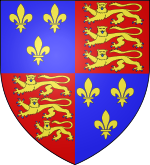 Royal Coat of Arms |
| Henry VIII |
| Henry, Duke of Cornwall |
| Mary I |
| Elizabeth I |
| Edward VI |
Henry VIII was the first English monarch to regularly use the style "Majesty", though the alternatives "Highness" and "Grace" were also used.
Several changes were made to the royal style during his reign. Henry originally used the style "Henry the Eighth, by the Grace of God, King of England, France and Lord of Ireland". In 1521, pursuant to a grant from Pope Leo X rewarding a book by Henry attacking Martin Luther, the royal style became "Henry the Eighth, by the Grace of God, King of England and France, Defender of the Faith and Lord of Ireland". Following Henry's excommunication, Pope Paul III rescinded the grant of the title "Defender of the Faith", but an Act of Parliament declared that it remained valid; and it continues in royal usage to the present day.
In 1535, Henry added the "supremacy phrase" to the royal style, which became "Henry the Eighth, by the Grace of God, King of England and France, Defender of the Faith, Lord of Ireland and of the Church of England in Earth Supreme Head". In 1536, the phrase "of the Church of England" changed to "of the Church of England and also of Ireland".
In 1541, Henry had the Irish Parliament change the title "Lord of Ireland" to "King of Ireland" with the Crown of Ireland Act 1542, after being advised that many Irish people regarded the Pope as the true head of their country, with the Lord acting as a mere representative. The reason the Irish regarded the Pope as their overlord was because Ireland had originally been given to the English King Henry II by Pope Adrian IV in the twelfth century as a feudal territory under papal overlordship. The meeting of Irish Parliament that proclaimed Henry VIII King of Ireland was the first meeting attended by the Gaelic Irish chieftains as well as the Anglo-Irish aristocrats. The style "Henry the Eighth, by the Grace of God, King of England, France and Ireland, Defender of the Faith and of the Church of England and also of Ireland in Earth Supreme Head" remained in use until the end of Henry's reign.
Henry's motto was Coeur Loyal (true heart) and he had this embroidered on his clothes in the form of a heart symbol and with the word loyal. His emblem was the Tudor rose and the Beaufort portcullis.
As Duke of York, Henry used the arms of his father (i.e. those of the kingdom), differenced by a label of three points ermine. As king, Henry VIII's arms were the same as those used by his predecessors since Henry IV: Quarterly, Azure three fleurs-de-lys Or (for France) and Gules three lions passant guardant in pale Or (for England).
Ancestry
|
|
||||||||||||||||||||||||||||||||||||||||||||||||||||||||||||||||||||||||||||||||||||||||||||||||||||||||||||||||||||||||||||||||||||||||||||||||||||||||||||||||||||||||||||||||||||||||||||||||||||||||||||||||||||||||||||||||||||||||||||||||||||||||||||||||||||||||||||||||||||||||||||||||||||||||||||||||||||||||||||||||||||||||||||||||||||||||||||||||||||||||||||||||||||||||||||||||||||||||||||||||||||||||||||||||||||||||||||||||||||||||||||||||||||||||||||||||||||||||||||||||||||||||||||||||||||||||||||||||||||||||||||||||||||||||||||||||||
|---|---|---|---|---|---|---|---|---|---|---|---|---|---|---|---|---|---|---|---|---|---|---|---|---|---|---|---|---|---|---|---|---|---|---|---|---|---|---|---|---|---|---|---|---|---|---|---|---|---|---|---|---|---|---|---|---|---|---|---|---|---|---|---|---|---|---|---|---|---|---|---|---|---|---|---|---|---|---|---|---|---|---|---|---|---|---|---|---|---|---|---|---|---|---|---|---|---|---|---|---|---|---|---|---|---|---|---|---|---|---|---|---|---|---|---|---|---|---|---|---|---|---|---|---|---|---|---|---|---|---|---|---|---|---|---|---|---|---|---|---|---|---|---|---|---|---|---|---|---|---|---|---|---|---|---|---|---|---|---|---|---|---|---|---|---|---|---|---|---|---|---|---|---|---|---|---|---|---|---|---|---|---|---|---|---|---|---|---|---|---|---|---|---|---|---|---|---|---|---|---|---|---|---|---|---|---|---|---|---|---|---|---|---|---|---|---|---|---|---|---|---|---|---|---|---|---|---|---|---|---|---|---|---|---|---|---|---|---|---|---|---|---|---|---|---|---|---|---|---|---|---|---|---|---|---|---|---|---|---|---|---|---|---|---|---|---|---|---|---|---|---|---|---|---|---|---|---|---|---|---|---|---|---|---|---|---|---|---|---|---|---|---|---|---|---|---|---|---|---|---|---|---|---|---|---|---|---|---|---|---|---|---|---|---|---|---|---|---|---|---|---|---|---|---|---|---|---|---|---|---|---|---|---|---|---|---|---|---|---|---|---|---|---|---|---|---|---|---|---|---|---|---|---|---|---|---|---|---|---|---|---|---|---|---|---|---|---|---|---|---|---|---|---|---|---|---|---|---|---|---|---|---|---|---|---|---|---|---|---|---|---|---|---|---|---|---|---|---|---|---|---|---|---|---|---|---|---|---|---|---|---|---|---|---|---|---|---|---|---|---|---|---|---|---|---|---|---|---|---|---|---|---|---|---|---|---|---|---|---|---|---|---|---|---|---|---|---|---|---|---|---|---|---|---|---|---|---|---|---|---|---|---|---|---|---|---|---|---|---|---|---|---|---|---|---|---|---|---|---|---|---|---|---|---|---|---|---|---|---|---|---|---|---|---|---|---|---|---|---|---|---|---|---|---|---|---|---|---|---|---|---|---|---|---|---|---|---|---|---|---|---|---|---|---|---|---|---|---|---|---|---|---|---|---|---|---|---|---|---|---|---|---|---|---|---|---|
|
||||||||||||||||||||||||||||||||||||||||||||||||||||||||||||||||||||||||||||||||||||||||||||||||||||||||||||||||||||||||||||||||||||||||||||||||||||||||||||||||||||||||||||||||||||||||||||||||||||||||||||||||||||||||||||||||||||||||||||||||||||||||||||||||||||||||||||||||||||||||||||||||||||||||||||||||||||||||||||||||||||||||||||||||||||||||||||||||||||||||||||||||||||||||||||||||||||||||||||||||||||||||||||||||||||||||||||||||||||||||||||||||||||||||||||||||||||||||||||||||||||||||||||||||||||||||||||||||||||||||||||||||||||||||||||||||||
Marriage and issue
| Name | Birth | Death | Notes |
|---|---|---|---|
| By Queen Catherine of Aragon (married 11 June 1509 annulled 23 May 1533) | |||
| Miscarried daughter | 31 January 1510 | ||
| Henry, Duke of Cornwall | 1 January 1511 | 22 February 1511 | |
| Unnamed son | November 1513 | ||
| Henry, Duke of Cornwall | December 1514 | ||
| Queen Mary I | 18 February 1516 | 17 November 1558 | married 1554, Philip II of Spain; no issue |
| Unnamed daughter | 10 November 1518 | ||
| By Queen Anne Boleyn (married 25 January 1533 annulled 1536) beheaded | |||
| Queen Elizabeth I | 7 September 1533 | 24 March 1603 | never married, no issue |
| " Henry Tudor" | 1534 | Historians are uncertain if the child was born and died shortly after birth, or if it had been a miscarriage. The affair was hushed up and we cannot even be certain of the child's sex. | |
| " Edward Tudor" | 29 January 1536 | ||
| By Queen Jane Seymour (married 30 May 1536; died 25 October 1537) | |||
| King Edward VI | 12 October 1537 | 6 July 1553 | |
| By Queen Anne of Cleves (married 6 January 1540 annulled 1540) | |||
| no issue | |||
| By Queen Catherine Howard (married 28 July 1540 annulled 1541) beheaded | |||
| no issue | |||
| By Queen Catherine Parr (married 12 July 1543; died 5 September 1548) | |||
| no issue | |||
| By Elizabeth Blount | |||
| Henry Fitzroy, Duke of Richmond and Somerset | 15 June 1519 | 18 June 1536 | illegitimate; married 1533, the Lady Mary Howard; no issue |
| By Mary Boleyn (Some writers, such as Alison Weir, now question whether Henry Carey was fathered by Henry VIII. ) |
|||
| Catherine Carey, Lady Knollys | c. 1524 | 15 January 1568 | married Sir Francis Knollys; had issue |
| Henry Carey, Baron Hunsdon | 4 March 1526 | 23 July 1596 | married 1545, Ann Morgan; had issue |
| By Mary Berkeley (There is no evidence to prove he was Henry's son except through eye witness accounts, who claimed a resemblance to the King.) |
|||
| John Perrott | c. 1527 | 3 November 1592 | married 1. Anne Cheney; 2. Jane Pruet, both of whom produced issue. He also had issue with his mistress Sybil Jones. |
